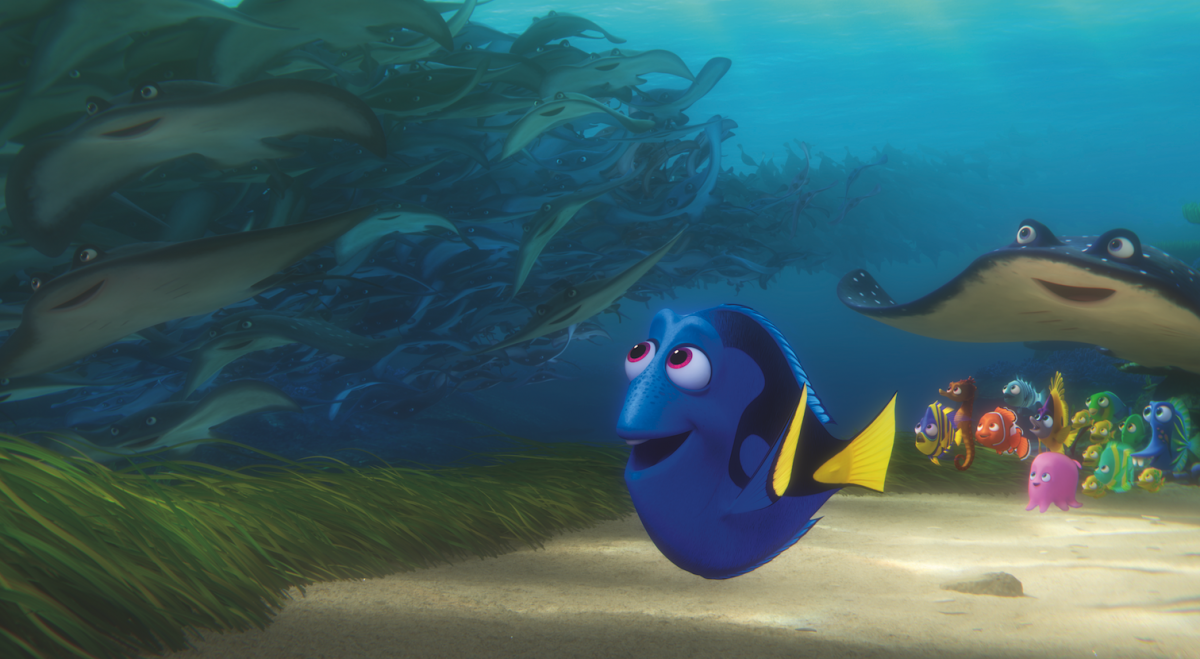
Piper, the impossibly adorable Pixar short that accompanies Finding Dory, is actually a pretty perfect prologue to the main film. In it, a beach-dwelling baby bird, her beak wide open, eagerly waits for her mama to bring her food. But it’s time for Piper to fend for herself, so her mother coaxes her to the shore, where other birds are pecking at the contents of seashells. After tentatively hopping her way over to join them, Piper is enveloped by a powerful wave—which finally recedes, leaving her wet, scared, but no worse for the wear. The film, which goes on to show how Piper not only overcomes her fears, but embraces them, tackles the same themes as Finding Dory: The world is full of danger and wonder and you are stronger than you think.
If you’ll recall in 2003’s Finding Nemo, it was Dory (the voice of Ellen DeGeneres), a blue tang fish with no short-term memory, who helped clown fish Marlin (Albert Brooks) find his lost son Nemo (Hayden Rolence). As the new film starts, the three of them have settled into life as a kind of makeshift family when Dory suddenly remembers that she has a family of her own—and they are probably looking for her.
Finding Dory follows much of the same pattern as Finding Nemo. Dory gets separated from Marlin and Nemo and sets off on her own, as Marlin and Nemo venture to find her. Eventually, they all end up at a Marine Life Preserve, where the father and son encounter a couple of wise-cracking sea lions and a daft, yet extremely helpful loon named named Becky, who carries them in a bucket with her beak. Dory befriends a 7-legged octopus named Hank (Ed O’Neill), a partially blind whale shark named Destiny (Kaitlin Olson), and a beluga whale named Bailey (Ty Burrell), who doesn’t quite trust his own sonar skills.
As you can see, most of the characters here have some sort of crisis of confidence or “flaw”—no short term memory, a missing limb, faulty vision, etc.—which they come to find out are secret strengths. “What would Dory do?” Nemo and Marlin ask each other during one pesky predicament. (Instead of overanalyzing every last detail, like Marlin would, she would act, boldly, on instinct.) And later, Dory herself—briefly scared and alone—asks the very same question, “What would Dory do?”—meaning how would she act as her best self, the Dory who isn’t afraid.
This is a powerful message of course, but now I’m making the film sound treacly and didactic, which it isn’t. Being a Pixar film it is, of course, eye-poppingly rich with color and detail. (The glowy underwater light of the film is particularly breathtaking). DeGeneres is reliably funny, stammering through Dory’s bemused reaction to a world she can’t expertly navigate with her trademark droll timing—but she’s also surprisingly poignant. As usual, this Pixar film will have you laughing and crying in equal measure (a bit involving a trail of sea shells will positively destroy you.)
My only real objection is a minor one: Late in the film Dory and co. seem to get themselves in an impossible pickle. “How are they going to write themselves out of this one?” I wondered, anticipating the trademark Pixar ingenuity. Instead, their solution was to have Hank, the octopus, drive a freaking truck. Look, I realize this is a fantasy world, filled with anthropomorphized animals and an abundance of imagination and whimsy, but it still follows its own internal logic. For example, the film goes through great trouble to make sure that Dory, Marlin, and Nemo are always submerged in water—whether in a bucket, a bowl, or a cup—because otherwise they couldn’t breathe. So when Hank got behind the wheel of that truck, I groaned a bit. Yes, I’m willing to believe in a talking whale, a heroic loon, a blue tang fish on a journey of self discovery, but I draw the line at a truck-driving octopus. Girl’s gotta have her limits.
